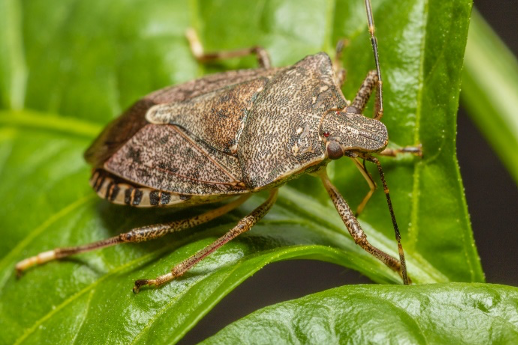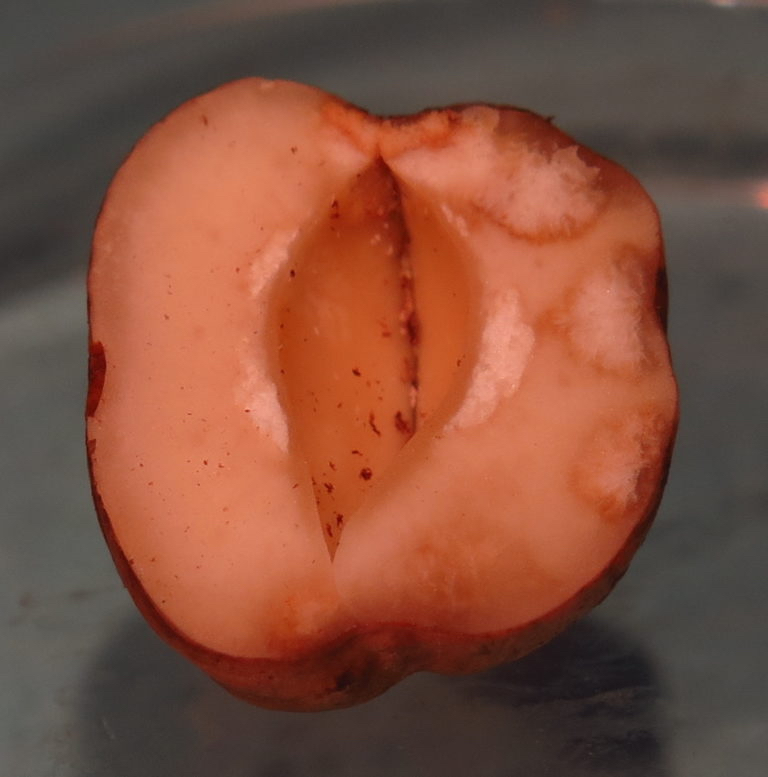
Hazelnut growers are no strangers to battling invasive and destructive species. Farmers famously battled back from the brink of disaster after Eastern Filbert Blight came to Oregon and decimated the industry in the 1980s and 1990s. Pests in all shapes and sizes have come to Willamette Valley for decades with a taste for hazelnuts. Contemporary growers are gearing up for a battle with an insect that made it ways to Oregon in the 2000s and now has a voracious appetite for hazelnuts—brown marmorated stink bug.
Brown marmorated stink bug (BMSB) is part of the Pentatomidae family, a group of insects recognized by their shield-like bodies and five-segmented antennae. Species within this family also have piercing sucking mouthparts, which enable them to feed on plants and, in turn, cause them to be devastating to farm crops.
BMSB eggs can hatch in four-to-six days and grow through five nymphal stages before reaching adulthood; they can begin feeding on plant tissues as early as the second nymphal phase. Prior to adulthood, the bugs cannot fly. However, as fully formed adults, their wings develop, and they become highly mobile.
High Adaptability
BMSB is native to Asia, and according to Oregon State University researchers, was first found in Portland, Ore. in 2004. The first evidence of BMSB in hazelnuts was noticed in 2014. The bugs have shown tremendous adaptability; they have been found in more than 43 states, in both rural and urban areas. They prefer to overwinter in buildings, which made urban areas an attractive home for the newly introduced pests. However, over time, it has been discovered they can overwinter in layers of tree bark.
Research is still ongoing as to the stink bug’s preferred habitats, but they have been found on more than 200 plant species, ranging from urban flower beds to rural farmland and forests. They have shown great affinity for maple trees; this attraction to trees has also contributed to a more pervasive infestation in the woodier northern part of the Willamette Valley and lesser impact, albeit still problematic, on the southern reaches.
Their adaptability also expands to dietary needs. BMSB can survive on an array of plant materials, including leaves and sticks, but they are mostly drawn to proteins, which makes hazelnuts such an attractive target. BMSB will feast on nuts and fruiting bodies of many plants, hazelnut kernels included. With their piercing sucking mouthparts, the insects can penetrate the outer shell of a hazelnut and gorge on the kernel inside. Hazelnuts are also one of the final crops harvested in the Willamette Valley, which means the stink bugs will congregate in the orchard when other foodstuffs are gone; this further prolongs the damage that can be inflicted on hazelnuts.
This is where concern becomes paramount for hazelnut growers—quality. BMSB haven’t shown much impact on overall hazelnut yields as they don’t cause significant damage to root systems, leaves, catkins or flowers.
However, they can destroy the kernel without growers even knowing. The puncture wounds on the shell can be hard to detect, and the marred kernels will not be revealed until after nuts have been harvested and processed.
This is known as “corking damage”. If the nuts are damaged, they cannot be sold by the processors, which in turn limits what they can pay back to farmers. As for varietal impact, researchers say there may be some preferences for certain varieties over others, but all production varieties in Oregon should be considered susceptible.

Samurai Wasps for Biocontrol
Farmers are now racing to find solutions to combat BMSB and protect their livelihood. Oregon State University (OSU) researchers have been the leaders on this front and are continually exploring new avenues for optimum treatment. Perhaps the most promising and intriguing is a biological control that recently debuted on U.S. soil—samurai wasps. The wasp was a candidate for release but was accidentally introduced. First discovered in Oregon in 2015, the samurai wasps have shown promise in mitigating BMSB. The wasp is a natural enemy endemic to the same regions in East Asia as BMSB.
Samurai wasps are tiny, less than two millimeters in length and are a parasitoid that specializes in hunting stink bug eggs. BMSB lay their eggs on the underside of leaves, typically in bundles of 28. The samurai wasp will hunt down these eggs, pierce them and inject their own eggs inside the BMSB egg. This parasitizes the BMSB, killing them and yielding a new generation of samurai wasps. The BMSB eggs are white to blue-white, and when they are parasitized, they turn black. Once fully developed, the samurai wasps will chew their way out of the eggs and take flight in the orchard. As this cycle perpetuates, more and more samurai wasps permeate the orchard and attack the harmful stink bugs.
Thus far, samurai wasps have proven to be the most effective biological control for hazelnuts. The wasps have not negatively impacted any other species and have been more aggressive in their mitigation of BMSB. Additionally, the wasps can lessen the need for insecticide application.
Samurai wasps are limited due to their ability to only impact the eggs; if the stink bugs can hatch, the wasps are not predatory. Except for some birds, there are no known predators in the Willamette Valley for adult brown marmorated stink bugs. By that stage, chemical applications may be the only option. Growers should be very judicious in any applications and work with professional field agronomists or OSU extension agents before applying.
For Oregon’s hazelnut growers and brown marmorated stink bugs, the battle has just begun. Researchers are dedicating more and more time into best practices to combat the pests, but they are here to stay. With such adaptability and the ability to thrive in an array of host environments, BMSB has found a comfortable home in the Willamette Valley. It will take diligence, patience and meticulous control measures for farmers to prevail, yet again.











